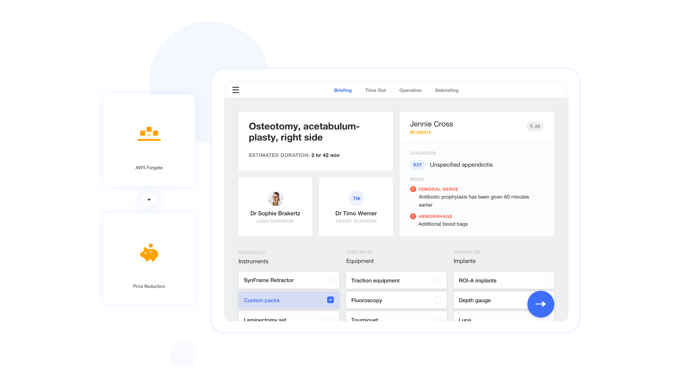Ruby on Rails vs Node.js: A Comparison of Frameworks for Web Development in 2023

This similarity means that the two leading backend frameworks offer a variety of benefits depending on the use case. In this article, we compare Ruby on Rails with Node.js, explaining what each environment has to offer when it comes to software development.
Given that both Ruby on Rails (RoR or Rails) and Node.js are wildly popular among web developers, you might be wondering which technology to choose for your next project. The decision may not be straightforward, as both Ruby on Rails and Node.js have their different advantages and limitations.
In this article, we will give you a detailed comparison of these two technologies and explain in which cases Ruby on Rails may be a better choice than Node.js, and vice versa.
RoR or Node.js: Choosing the right framework based on project needs
Ruby on Rails and Node.js have distinct differences that make one better than the other in specific scenarios. Ruby on Rails, for example, is difficult to maintain in the long run if you’re dealing with inexperienced developers. However, its rich ecosystem and countless libraries make it easy to “assemble applications”, meeting tight budgets and deadlines.
On the other hand, we have Node.js, which can be faster considering its use of Google’s V8 but whose single-thread processing mechanism can lead to significant performance issues and high resource demand.
In short, picking between Rails and Node.js depends on your projects’ specific needs. Here are some scenarios where you should choose one over the other.
When to choose Ruby on Rails?
This backend framework for web applications is appreciated, especially for scalability and efficiency. Developers should choose it over Node.js in their backend frameworks in the following cases:
- When RAD (Rapid Application Development) is critical – Fast prototyping is the philosophy of Rails. In a few commands, you can have a fully functional prototype that may be amended with additional features later.
- For full-stack web applications – As Ruby on Rails has a lot of rules for organization (the model-view-controller framework), it yields efficient code that is easy to read, maintain, and edit.
- When building content management systems – While PHP remains the go-to language for CMS development, Ruby on Rails demonstrates significant advantages in this field. Its high abstraction levels allow it to program rich functionalities with little programming work.
- When building an MVP – In such cases, you would prioritize operational efficiency and a solid development process over speed and an impeccable interface. Multiple command-line builders, open-source libraries, and ready-to-use code will be of great benefit.
- For CPU-intensive tasks – Ruby on Rails is efficient at computation on vast arrays of data. Node.js single-threaded environment simply isn’t designed for CPU-intensive operations.
If you’d like to learn more about all the advantages and use cases of Node.js, take a look at some of the projects we worked on: Neveo, Artemest, and National University System.

Artemest: Upgrading Market Platform
When to choose Node.js?
Node.js is often chosen for building high-performance web apps. With this environment, developers can increase the development speed by running the same JavaScript (JS) code on both backend technology and frontend technology, simplifying the entire process. This means that Node.js will add the following advantages in these scenarios:
- In server-side development – As Node.js establishes good communication between the server and the browser and can handle multiple incoming requests simultaneously, it’s perfect for developing real-time apps such as messengers, online games, and real-time collaboration platforms.
- When performance and scalability are the priority – When comparing Ruby with Node.js, the latter is more lightweight, so it will be more stable and easy to scale.
- In API development – Most developers choose Node.js for REST (Representational State Transfer) API development, which is particularly useful in programming web applications. Node.js can quickly process user requests and yield an output quickly. For that reason, it’s also commonly used to develop single-page applications.
- When building microservices – Node.js does a great job handling multiple concurrent requests and heavy I/O operations thanks to non-blocking processing and a fast V8 engine, so it’s effective at handling hundreds of internal requests simultaneously.
You can take a look at some of our Node.js projects: Nodus, Moonfare, and Home Made.

Nodus: Increasing efficiency in documenting surgical procedures
Let’s go through different aspects and confront the two frameworks for web application development.
Performance
Node.js is a fast server-side solution and its core strength is high-performance. The technology offers an innovative application of asynchronous processing and event-based programming that also avoids I/O blockage and improves runtime performance. It maximizes the usage of a single CPU and computer memory. With that, Node.js servers can process more concurrent requests than conventional multi-threaded servers. Indeed, Node is one of the fastest server-side solutions around.
Yet, Node.js can be less efficient with CPU-intensive operations because its asynchronous and single-threaded models have certain limitations: They are not so efficient when it comes to handling CPU-intensive tasks, such as generating graphics or resizing images. Luckily, a workaround of making a new task queue to manage CPU-intensive requests exists. However, it requires spawning additional workers and introducing new layers to your Node.js application.
When comparing Ruby on Rails with Node.js, Rails is somewhat slower, as it’s heavier than most alternatives due to its provision of out-of-the-box modules. RoR is also less efficient at handling multiple concurrent requests and managing simultaneous requests. The only solution to this is using additional server instances, which will consume more memory.
However, the specific performance characteristics of each framework can vary depending on the specific use case and implementation details.
Architecture
Ruby on Rails follows a Model-View-Controller (MVC) architecture, which provides a way to organize code into three distinct layers: the model, which handles data storage and retrieval; the view, which handles the presentation of data to users; and the controller, which handles user input and communicates with the model and view layers.
This architecture can make it easier to organize code and to separate concerns, allowing for more maintainable and scalable applications.
Node.js, on the other hand, is more flexible in terms of application architecture, and does not prescribe a specific architecture like MVC. Node.js applications can be structured in many different ways, depending on the specific requirements of the project.
One popular approach is to use a microservices architecture, in which different parts of the application are broken down into smaller, independent services that communicate with each other over a network.
Flexibility
Node.js is often considered more flexible than Ruby on Rails because it is designed to be highly modular and provides a lot of freedom to developers in terms of how they structure their code and implement specific functionality.
Node.js allows developers to use a wide range of libraries and modules from the extensive npm package registry, which provides a huge amount of flexibility in terms of what can be accomplished with the framework. This modular architecture makes it easier to create custom solutions that are tailored to specific requirements, rather than being forced to use a set of predefined conventions.
Furthermore, Node.js event-driven, non-blocking I/O architecture also provides a lot of flexibility in terms of how applications are designed and deployed. It allows developers to easily build highly scalable applications that can handle a large number of requests concurrently, making it a good choice for building microservices or other distributed systems.
If your application has a unique functionality and demands that Ruby on Rails does not support commits out of the box (e.g., two-phase ones), it may be hard to adjust the framework to your product’s needs.
As an opinionated framework, Rails is authoritative in dictating the app development process, so you may get to a point when adjusting the framework would take more time than building the app from scratch using a less opinionated framework.
However, it's worth noting that the flexibility of a framework is always a trade-off between ease of use and customization. While Ruby on Rails may be less flexible in some ways, it is also designed to make it easier for developers to build web applications quickly and efficiently by providing a set of conventions and tools that can save time and effort.
Scalability
Node clusters and workers are abstractions that can spawn additional Node.js processes depending on the workload of your web application. Limited only by the number of CPUs at their disposal, you can easily scale your Node applications to fully functional enterprise software solutions.
Node.js is generally considered to be more scalable than Ruby on Rails due to its event-driven, non-blocking I/O architecture, which allows it to handle a large number of requests concurrently. This makes Node.js a good choice for building highly scalable web applications that need to handle a large number of concurrent connections.
However, both Node.js and Ruby on Rails can be made scalable with the right architecture and deployment strategies, and the choice between them ultimately depends on the specific requirements and goals of the project.
Development speed
Ruby on Rails has a rich and well-developed infrastructure that offers a fully integrated web server solution (Puma web server) and Active Record database that allows abstracting schema and models. Moreover, Rails features generators – powerful scripts that allow one to rapidly scaffold an RoR application.
Rails provides a wide range of pre-built tools and libraries that can help developers build applications more quickly and efficiently, as well as a set of conventions for organizing code and handling common web development tasks. All of this makes Rails suitable for rapid prototyping and deployment of web applications, increasing the overall speed of building web applications.
Node.js, on the other hand, provides a lot of flexibility and modularity, which can make it easier to create custom solutions that are tailored to specific requirements. Node.js also has a large ecosystem of modules and libraries available through the npm package registry, which can help speed up development by providing pre-built functionality that can be easily integrated into applications.
Portability across various database platforms
Ruby on Rails is easy to migrate across various database platforms. The active model that underlies the Rails default database, Active Record, can easily abstract the differences between various SQL backends. Thus, Ruby on Rails allows for the creation of database-agnostic schemas and models that simplify the migration of Rails applications across different database environments.
In contrast, Node.js typically requires developers to use more low-level database drivers or ORMs, which may require more effort and expertise to migrate between different database platforms. While there are several popular ORMs available for Node.js, such as Sequelize and TypeORM, they may not offer the same level of abstraction and consistency as ActiveRecord in Ruby on Rails.
Documentation
Node’s flexibility can sometimes backfire on those who want to quickly deploy their web applications. Node.js leaves the selection of modules to the developer, and the choice may not always be obvious. They also have to integrate the chosen modules, which means that more planning, time, and effort may be required to bootstrap a Node.js project.
An application can depend on dozens of modules, and wrong choices may result in unexpected behavior. It is thus crucial to have an experienced developer in your team to avoid major issues.
Rails has no official documentation per se, plus external libraries and packages will often have poor documentation. Using Ruby’s gems will thus require the developer to extensively dive into the code to understand the library. This endeavor costs the business time and resources.
If you’d like to dive deeper into the pros and cons of Ruby on Rails, check out our other article on RoR Pros and Cons.
Key differences: Ruby on Rails vs. Node.js
Here’s a short cheat sheet with key differences between Node.js and Ruby on Rails:
- Compared with Ruby on Rails, Node.js will work faster on the server side thanks to its event-based programming and non-blocking I/O usage of a single CPU.
- Node.js has a gentler learning curve than Ruby (and for those who come from different programming backgrounds). On the other hand, Rails offers more learning resources and has a large supporting community online.
- Node.js is very flexible, while RoR has a predetermined application structure.
- When it comes to operations, Ruby on Rails supports multi-threading and is more suitable for CPU-intensive use cases. In contrast, Node.js is single-threaded, unsuitable for CPU-intensive applications, but works well in I/O-heavy use cases.
- Ruby on Rails works sequentially (there are no callbacks), while Node.js works asynchronously (has callbacks).
- RoR code is rule-heavy and thus easy to maintain, whereas Node.js has no rules and so maintaining the code may be tricky.
- The Node.js API changes frequently, hence the framework is inconsistent. Ruby, meanwhile, changes infrequently and is therefore much more consistent.
- Node.js, with its node package manager, has a larger collection of libraries than Ruby on Rails.
Ruby on Rails vs Node.js comparison table
|
Ruby on Rails |
Node.js |
|
|
Programming language |
Ruby |
JavaScript |
|
Applications |
Backend development |
Backend and frontend development |
|
# of threads |
Multi-threaded |
Single-threaded |
|
Framework type |
Opinionated; doesn’t offer much control. |
Non-opinionated; offers more control. |
|
Development time |
Quick; few commands via command line. |
Time-consuming; requires writing the code, selecting modules, and integrating them. |
|
Performance |
Relatively slower than Node.js |
Faster than Rails thanks to the JavaScript engine |
|
CPU-intensive tasks |
Well-suited for RAD, image processing, and data processing. |
Not suitable, as it’s single threaded. |
|
Scalability |
Not as scalable as Node.js |
More scalable thanks to clusters with abstractions |
|
Availability of talent |
Not immediately available |
Readily available |
|
Use cases |
MVP development, prototyping, CMS development. |
Real-time apps |
|
Open-source? |
Yes |
Yes |
How to choose between Ruby on Rails and Node.js?
Comparing Ruby on Rails vs Node.js, we know that both backend solutions are practical server-side development frameworks that will work well in a variety of projects. If you’re choosing a framework for your next software development project, consider the specific type of app you’re about to build and the tasks it will perform. Also, determine how much time you have at hand and what your scalability and performance needs are.
If you’re going for a CPU-intensive web app development and must deploy fast, opt for Ruby on Rails. In contrast, Node.js will be better suited for building RTAs, SPAs, and I/O-intensive tools where concurrency support is required.
Hopefully, you’ll be able to make an informed choice as you decide which framework to use for your web development project. If you have additional questions about Ruby on Rails or Node.js, feel free to contact us directly.




















